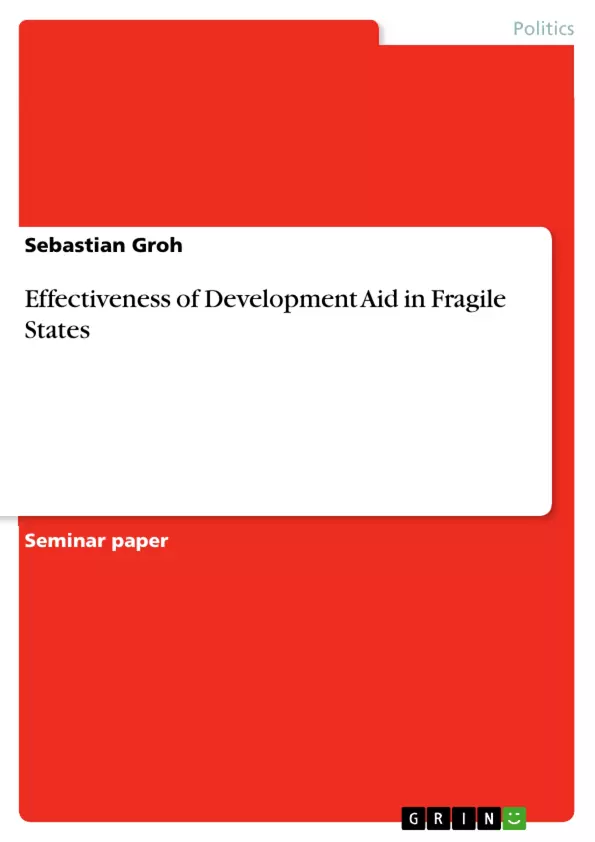What should we learn from our history of development aid? Development aid faces fundamental problems, especially in fragile states. These problems were addressed regularly by various representatives, academics, politicians and practitioners. The Samaritan Dilemma and a case study on used clothing is presented. It is clear that only having good intentions is not enough to help out the poor. The econometric analysis on aid effectiveness has repeatedly offered hope and repeatedly disappointed. There are several reasons why the aid flow increases anyway. Chauvet and Collier (2004) use a different approach and show potential for efficiency enhancements, but their analysis suffers from several caveats. Nevertheless, potential is shown and the authors indicate how to address the problem. Furthermore, the idea of social businesses is introduced as a market based mechanism which allows for feedback and accountability.
Recent initiatives, primarily pushed by private actors, give reason for hope. It is on the governments to provide the basic conditions in the fragile states and to back those initiatives which so far show the best results.
Inhaltsverzeichnis (Table of Contents)
- Introduction: Despite good intentions - criticism on development aid
- Fragility and poverty efficiency
- Development and Aid
- The Samaritan Dilemma
- Used-clothing and production - a case study
- Econometric problems in the literature of aid effectiveness
- The potential of efficiency improvements in fragile states
- Promoting turnarounds
- Sustaining turnarounds
- Recent proposals for more effective aid in fragile states
- Conclusion
Zielsetzung und Themenschwerpunkte (Objectives and Key Themes)
This seminar paper analyzes the effectiveness of development aid in fragile states. It aims to critically evaluate the impact of aid on poverty reduction and economic growth in these contexts, considering the complexities of fragility and the challenges of aid effectiveness. Key themes include:- The controversial nature of development aid effectiveness
- The role of fragility in influencing aid effectiveness
- The "Samaritan Dilemma" and its implications for aid interventions
- Econometric challenges in measuring aid effectiveness
- Potential strategies for improving aid effectiveness in fragile states
Zusammenfassung der Kapitel (Chapter Summaries)
- Introduction: The chapter introduces the topic of development aid effectiveness, highlighting the significant amount of aid provided globally and the controversies surrounding its impact. It defines "fragile states" and explains the concept of aid effectiveness, emphasizing the importance of an optimal input-output ratio. The chapter then presents conflicting evidence on the impact of aid, citing both positive and negative perspectives on its effectiveness.
- Fragility and poverty efficiency: This chapter delves deeper into the relationship between state fragility and the effectiveness of development aid. It explores the complexities of fragile states and their impact on the ability of aid to promote sustainable development and poverty reduction.
- Development and Aid: This chapter focuses on specific challenges related to aid effectiveness in fragile states. It explores the "Samaritan Dilemma," where aid can unintentionally undermine local economic development. It also examines the issue of used clothing imports, using it as a case study to highlight the potential negative consequences of certain aid interventions.
- Econometric problems in the literature of aid effectiveness: This chapter analyzes the methodological challenges of measuring the impact of development aid. It discusses the difficulties in isolating the specific effects of aid from other factors influencing economic development. The chapter explores the use of econometric models and the limitations inherent in their application.
- The potential of efficiency improvements in fragile states: This chapter explores strategies for improving the effectiveness of development aid in fragile states. It considers the potential of "turnarounds" – successful shifts towards more effective aid interventions – and examines approaches for promoting and sustaining these positive changes.
- Recent proposals for more effective aid in fragile states: This chapter examines contemporary initiatives and proposals for more effective aid in fragile states. It explores innovative approaches to aid delivery, focusing on specific recommendations for improving the impact of aid in these challenging environments.
Schlüsselwörter (Keywords)
The main keywords and focus topics of this seminar paper are: development aid, fragile states, aid effectiveness, poverty reduction, economic growth, Samaritan Dilemma, econometric analysis, turnarounds, sustainable development, and policy recommendations.- Quote paper
- Sebastian Groh (Author), 2009, Effectiveness of Development Aid in Fragile States, Munich, GRIN Verlag, https://www.grin.com/document/144916



